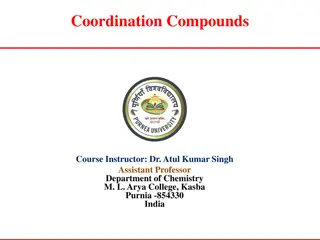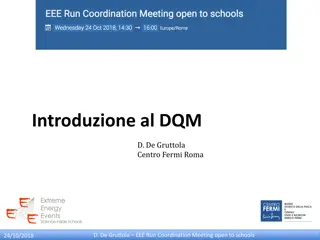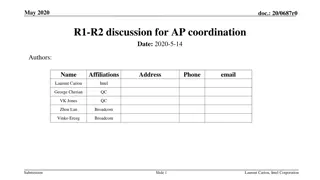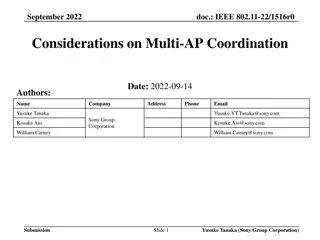CHILD PROTECTION COORDINATION IN MIXED SETTINGS SHARING GOOD PRACTICES
Explore the effective coordination mechanisms and best practices for child protection in mixed settings involving refugees, internally displaced populations, and other affected groups. Topics include similarities, differences, system strengthening, rights-based approaches, coordination responsibilit
2 views • 25 slides
Introduction to Co-ordination Chemistry: Fundamentals and Applications
Explore the fascinating field of coordination chemistry, delving into the complexity of compounds and the coordination bonds that govern their structures. Discover the history, key concepts, and applications of coordination chemistry through a detailed examination of coordination compounds, bonding
13 views • 73 slides
Enhancing R-TWT with Multi-AP Coordination in IEEE 802.11 Networks
Delve into the world of IEEE 802.11 wireless networks as this document explores solutions for multi-AP coordination for R-TWT, focusing on improving tail latency, jitter, and medium protection. Enhancements in R-TWT operation, coordination scenarios, and solutions for multi-AP deployments are discus
1 views • 12 slides
Priority Activities and Action Plan for EW4All Infrastructure Commission: INFCOM-3 Session
The document outlines the priority activities and action plan for the Third Session of the Infrastructure Commission (INFCOM-3) within the Early Warnings for All initiative. It includes background decisions, a draft list of priority activities, and an action plan for contributions to the initiative.
5 views • 10 slides
COORDINATION PATTERNS
Coordination patterns play a crucial role in designing concurrent code, ensuring smooth operation and efficient performance. They help in managing interactions between threads or processes, preventing malfunctions and performance drops. Examples like producer-consumer pattern and bounded buffers ill
1 views • 69 slides
Understanding the Theory of Coordination Failure in Markets
The theory of coordination failure explores how markets may struggle to achieve coordination among complementary activities, leading to suboptimal outcomes. It highlights scenarios where investors' actions depend on each other, emphasizing the role of government intervention to solve coordination is
2 views • 14 slides
Localisation in Child Protection Coordination: A Conceptual Framework
This presentation explores the preliminary conceptual framework and approach for localisation in child protection coordination. It delves into the roles of local actors, coordination systems, governance, decision-making, partnerships, and funding in promoting localisation efforts. The importance of
0 views • 22 slides
Improving Food and Nutrition Security Coordination Structure in Namibia
The document outlines the establishment, evolution, and recent developments in the coordination structure for food and nutrition security in Namibia, with a focus on government commitment, stakeholder involvement, and coordination mechanisms. It highlights the transition from dormant entities to the
0 views • 22 slides
Fiji National Cluster System for Disaster Risk Management
The Fiji National Cluster System for Disaster Risk Management emphasizes the importance of coordination in emergencies, aiming to reduce gaps and overlaps through a coherent, complementary approach. Global Cluster coordination systems have been adopted to enhance collaboration among various humanita
1 views • 22 slides
Understanding Humanitarian Landscape and Coordination Challenges
The humanitarian landscape involves various organizations working together to provide assistance during crises. Coordination challenges, such as identifying needs, existing assistance, and government involvement, have been prevalent. The Inter-Agency Standing Committee (IASC) was established in 1991
2 views • 21 slides
Inter-Cluster Coordination and Information Management in Humanitarian Emergencies
Inter-Cluster Coordination and Information Management play vital roles in humanitarian emergencies. The coordination mechanism involves regular meetings convened by the RC/HC and coordinated by OCHA, providing opportunities for clusters to collaborate on shared planning, needs assessments, and poole
3 views • 13 slides
Considerations on Inter-PPDU Based Preemption Scheme in IEEE 802.11-23
In this document, considerations are presented for a preemption scheme in IEEE 802.11-23, focusing on issues such as coordination, ACK transmission timing, and channel access fairness. The proposed inter-PPDU based preemption scheme aims to improve the transmission of low latency traffics within the
1 views • 12 slides
Understanding Coordination Compounds and Ligands in Chemistry
Coordination compounds involve ligands that donate electron pairs to central metal ions. Ligands can be categorized based on the number of donor atoms they contain, such as mono-, bi-, tri-, tetra-, penta-, and hexadentate ligands. Each type of ligand has the ability to form bonds with the central m
3 views • 15 slides
Understanding Complex Ions and Coordinate Bonds in Chemistry
Complex ions in chemistry are formed when transition metals or their ions bond with ligands through coordinate bonds. Ligands utilize their lone pairs of electrons to form dative covalent bonds with transition metals, determining the coordination number of the cation. Complex ions play a crucial rol
1 views • 29 slides
Information Management Roles and Responsibilities in Disaster Response Coordination
The roles and responsibilities of the coordination team in disaster response include key positions such as Cluster Coordinator, Information Manager, GIS Mapping Specialist, and more. National governments play a crucial role in safety, security, and coordination efforts. Exercises are conducted to ag
0 views • 11 slides
Transformative Agenda and Guidance for Effective Cluster Coordination
Explore the transformative agenda and guidance for cluster coordination, emphasizing the roles of UNICEF as a cluster lead agency, core cluster functions, inter-cluster coordination, and management strategies for effective humanitarian response. Key focus areas include accountability, human financin
2 views • 19 slides
Sub-National Coordination: Benefits and Implementation
Sub-national coordination allows for decentralized decision-making, close cooperation with stakeholders, and increased community involvement. This approach ensures quick response times, adaptation to local circumstances, and enhanced accountability to affected populations. Learn about the roles, adv
0 views • 7 slides
Coordinated Spatial Reuse in IEEE 802.11 Networks
The document discusses Coordinated Spatial Reuse (C-SR) in IEEE 802.11 networks, focusing on downlink transmission. C-SR is a multi-AP coordination scheme aimed at enhancing spectrum efficiency by reusing time/frequency resources among multiple Basic Service Sets (BSSs). The procedure is divided int
1 views • 24 slides
Sub-national Nutrition Cluster Coordination Training Workshop
Welcome to the Sub-national Nutrition Cluster Coordination Training Workshop aimed at sharing key concepts, tools, and approaches for effective coordination of nutrition in emergencies. This training prepares participants for working in Nutrition Cluster/Sector Coordination, promoting dialogue and s
1 views • 10 slides
Effective Data Taking and Quality Monitoring in EEE Run Coordination Meeting
The Data Quality Monitor (DQM) plays a crucial role in ensuring the effective data taking period in the EEE Run Coordination Meeting for schools. It involves monitoring key quantities using specific tools, analyzing data, and checking for correct behavior. The acquisition of data is essential for st
0 views • 33 slides
Kenya's NAP Progress Report Presentation: Challenges, Methodologies, and Lessons Learnt
Lerenten Lelekoitien, Deputy Director of Climate Change Adaptation, presented Kenya's NAP progress report in a virtual workshop. The presentation covered what is monitored in the M&E system, methodologies used, challenges encountered, and lessons learnt. Key aspects included identifying priority act
0 views • 7 slides
Enhancing Care Coordination Through Agreements
Effective care coordination is crucial for ensuring quality referrals and improving patient outcomes. Develop a Care Coordination Agreement to streamline the referral process, reduce waste, and enhance cost-effectiveness in healthcare delivery. This agreement serves as a roadmap for standardizing co
0 views • 49 slides
Camp Coordination Meeting - 2023 Objectives, Requirements, and Procedures
This document outlines the objectives, requirements, and procedures for the 2023 Camp Coordination Meeting. Objectives include improving coordination, enhancing communication, ensuring compliance with legal requirements, and increasing enrollment. Camp coordinators need to complete various forms, wh
0 views • 13 slides
Comparative Analysis of State Coordination in Higher Education Systems
This comparative perspective explores the state coordination of higher education in various states, highlighting the differences in governance structures, authority of boards, and levels of coordination. It cautions against replicating models due to unique state factors and emphasizes the distinct r
0 views • 17 slides
Feasibility of Care Coordination for Dual Eligibles: Characteristics and Opportunities
The Pacific Health Policy Group's report discusses the feasibility of care coordination for dual eligibles, individuals eligible for both Medicaid and Medicare with high rates of complex health conditions. Characteristics include having low incomes, chronic physical and mental health conditions, and
4 views • 52 slides
Coordination Numbers in Inorganic Compounds: Geometries and Structures
In inorganic coordination complexes, the coordination number refers to the number of atoms bonded to the central atom. Common geometries include octahedral, tetrahedral, and square planar, depending on the type and number of ligands. Transition metal complexes exhibit different coordination numbers
2 views • 8 slides
Understanding Coordination Chemistry: Structures, Isomers, and Naming
Exploring coordination chemistry involves understanding structures, isomers, naming conventions, and common coordination numbers, all essential in studying coordination compounds. Coordination compounds consist of central metals, ligands, and charge balancing ions. Naming involves listing cations, l
0 views • 46 slides
Crystal Field Theory and Color Exhibited by Coordination Compounds
Crystal Field Theory (CFT) explains the colors exhibited by coordination compounds based on the absorption of light and electron transitions in d-orbitals. The theory describes how ligands interact with transition metal ions, causing the d-orbitals to split in energy levels. This split results in th
0 views • 30 slides
Insights into Coordination Chemistry Elements and Complexes
Transition elements with d or f electrons possess unique properties, play crucial roles in biological processes, and form colorful complexes with ligands. Occurring widely in nature, these elements have varied oxidation states and coordination numbers. Werner's formulation sheds light on primary and
0 views • 41 slides
Proposal for Dynamic Multi-AP Coordination in IEEE 802.11-23
This proposal focuses on enhancing the reliability of multi-AP coordination in IEEE 802.11-23 through the formation and management of MAP (Multi-AP) groups. It discusses the limitations of the current setup and suggests a dynamic approach where multiple APs can form MAP groups flexibly. The document
0 views • 11 slides
Understanding Cluster Coordination Performance Monitoring (CCPM)
The Cluster Coordination Performance Monitoring (CCPM) is a self-assessment tool that helps evaluate cluster performance against core functions and Accountability to Affected Populations. It aims to improve coordination and accountability within clusters, developed by the IASC Sub-Working Group. Mon
0 views • 16 slides
Understanding Coordination Complexes and Transition Metals
Today's lecture covers transition elements, coordination complexes, ligand types, geometries, naming, isomers, and bonding in coordination complexes. Transition metals form coordination complexes with metal ions, ligands, and counter ions. The types of ligands include monodentate and bidentate ligan
1 views • 24 slides
Overview of Multilateral Frequency Coordination Meeting for Digital Dividend Implementation
The Multilateral Frequency Coordination Meeting discussed progress in implementing digital switchover and digital dividend in the GE06 countries. It highlighted the allocation of spectrum for mobile services and the importance of coordinated implementation. Various coordination groups in Region 1 wo
0 views • 14 slides
Enhancing Healthcare Emergency Preparedness and Response in Wisconsin
The Wisconsin Hospital Emergency Preparedness Program (WHEPP) focuses on supporting hospitals in planning and responding to mass casualty incidents and pandemics. It emphasizes the importance of healthcare coalitions, tier coordination, and disaster medical coordination centers. The program, funded
1 views • 30 slides
Proposal for Release 1/R2 Feature Split in Wireless AP Coordination
The proposal suggests modifying the split between Release 1 and Release 2 features for wireless AP coordination in order to address the lack of consensus on the low complexity AP coordination feature. It aims to enhance clarity and efficiency in the development process while maintaining the value of
0 views • 7 slides
Enhancing AP Coordination for Improved Wireless Network Performance
This document discusses considerations for Coordinated TDMA (C-TDMA) in IEEE 802.11 networks to address issues of limited coordination among Access Points (APs). The objective is to enhance coordination among APs to improve network reliability in terms of latency, throughput, and fairness. Design pr
0 views • 14 slides
IEEE 802.11-22/1516r0 AP Coordination Considerations
Review of discussions on AP coordination in WNG sessions and EHT SG/TGbe meetings, proposing advancements for future WLAN technology. Emphasis on the importance of prioritizing AP coordination to address various WLAN objectives effectively. Details on AP coordination subtypes and their impact on rel
0 views • 11 slides
Distributed Coordination Algorithms for Robotic Swarms: Challenges and Innovations
Explore the world of robotic swarms through the lens of distributed coordination algorithms. Discover various coordination tasks, synchronization models, and algorithm results, alongside the evolution of robot models for enhanced efficiency. Delve into coordinated movement, flocking behaviors, and t
0 views • 10 slides
Enhancing Care Coordination in the Medical Neighborhood
This content emphasizes the importance of ensuring high-value care coordination through effective referral processes and close-loop tracking in the medical neighborhood. It discusses key action steps, such as developing care coordination agreements and providing a high-value referral response. Furth
0 views • 26 slides
Submarine Cable Resiliency Update and Recommendations
Working Group 4A provides updates on the status of submarine cable resiliency, highlighting the risks to infrastructure due to lack of coordination across agencies and clustering of cable routes. The group aims to enhance regulatory coordination and promote geographic diversity to ensure network res
0 views • 7 slides







































